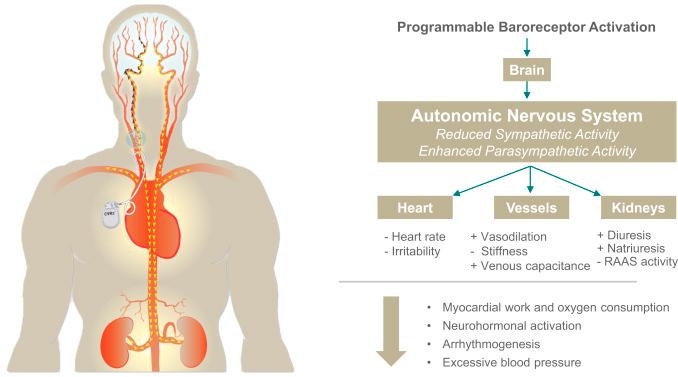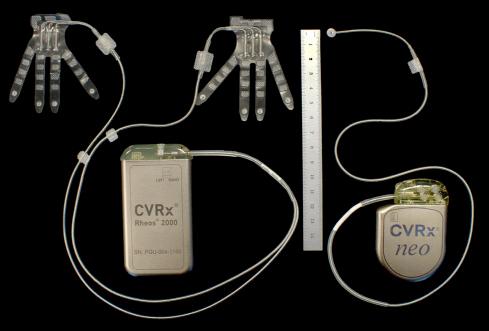Physical Address
304 North Cardinal St.
Dorchester Center, MA 02124
Hypertension is the leading cause of morbidity and mortality in the world with an incidence that continues to rise and currently affects 25% of the adult population, roughly 1 billion people, worldwide ( ). Long-standing, poorly controlled hypertension is associated with a higher incidence of stroke, myocardial infarction, cardiomyopathy, atherosclerotic disease, renal failure, and blindness. The SPRINT Trial found that even more intensive blood pressure (BP) control targets of <120/80 mm Hg compared to <140/90 mm Hg were associated with statistically significant reduction in the rates of fatal and nonfatal risk of major cardiovascular events or death ( ). The lifetime risk of heart failure for individuals with a BP > 160/90 is double that of individuals with a BP < 140/90 ( ).
Treatment-resistant hypertension (TRH) is defined as measured BP greater than 140/90 mmHg despite optimal doses of at least three antihypertensive agents including a diuretic ( ). Estimates of the prevalence of TRH range from 15% to 30% with observational studies like the National Health and Nutrition Examination Survey (NHANES) finding lower estimates and large prospective outcome studies, including the Anglo-Scandinavian Cardiac Outcome Trial (ASCOT) ( ), the Antihypertensive and Lipid-Lowering and Treatment to Prevent Heart Attack Trial (ALLHAT) ( ), and the Avoiding Cardiovascular Events in Patients Living with Systolic Hypertension (ACCOMPLISH) ( ), finding higher rates of uncontrolled hypertension despite at least three antihypertensive medications ( ). Analysis by Egan et al. of the NHANES data on hypertension in the United States from 1988 to 2008 found that the overall proportion of patients with untreated hypertension decreased when comparing the 1988–94 data to the 2005–08 data and the percentage of patients on two or fewer antihypertensive agents was unchanged, but there was an increase in the percentage of patient requiring ≥3 agents. Additionally, Dr. Egan and his colleagues found that in 2005–08 data, 28% of patients continued to have uncontrolled hypertension with systolic BP >140 mmHg or diastolic BP >90 mmHg despite treatment with three or more antihypertensive agents compared to 15% of patients 1988–94 date ( ). These findings demonstrate the increasing prevalence of TRH and at rates aligned with those found in ASCOT, ALLHAT, and ACCOMPLISH studies.
Pharmacologic medications are the mainstay of treatment for hypertension and are effective therapy for the majority of patients. Patients with TRH on optimal pharmacologic therapy may have increased sympathetic nervous system activation contributing to their resistant hypertension. The study of the role of sympathetic nervous system modulation and cardiovascular effects predates pharmacologic antihypertensive therapy with the first surgical sympathectomy, a surgical severing of the sympathetic ganglia, attempted during the 1930s in an effort to improve circulation and reduce vasoconstrictive effects in patients with peripheral vascular disease ( ). The technique was later applied to treatment of malignant hypertension in the 1940s and 1950s, though this application was short-lived given the considerable adverse side-effects associated with the procedure including severe orthostatic hypotension, impotence, and urinary or fecal incontinence ( ).
Advances in sympathetic modulation have shown promise in effectively reducing systemic hypertension without the morbidity associated with the early surgical predecessors. One of these new approaches being evaluated for long-term antihypertensive treatment is an implantable device, similar to a pacemaker, providing direct electrical stimulation to the baroreceptors of the carotid sinus to decrease sympathetic output and increase vagal tone to facilitate a centrally mediated decrease in systemic BP ( ).
BP regulation is a dynamic and multifactorial process that requires integration of three main systems: the cardiovascular system, in which the heart provides the mechanical pump and forward pressure, and blood vessels provide systemic vascular resistance; the kidneys, which largely control intravascular volume regulation; and the adrenal system, which supplies the hormones that regulate and integrate these components. The Renin-Angiotensin-Aldosterone System (RAAS) plays a significant role in regulating arterial BP and cardiac output through its influence on intravascular volume status and systemic vascular resistance.
A low BP or a decrease in BP in the afferent arterioles within the kidneys causes a reduction in the glomerular filtration rate (GFR) and decreased sodium delivery to the distal tubule which in turn leads to the release of renin into the blood stream. Renin then cleaves angiotensinogen to form angiotensin (AT) I, which in turn is cleaved by angiotensin-converting enzyme (ACE) to form angiotensin II. Once released, angiotensin II acts on the adrenal cortex to release aldosterone and the posterior pituitary to release antidiuretic hormone (ADH) both of which facilitate increased sodium and fluid reabsorption in the renal tubules to increase intravascular blood volume. Additionally, Angiotensin II acts on AT1 receptors to constrict vasculature thereby increasing systemic vascular resistance and arterial BP, stimulates cardiac and vascular hypertrophy, and stimulates sympathetic adrenergic function through the release of norepinephrine.
Atrial natriuretic peptide (ANP) and brain-type natriuretic peptide (BNP) are released in response to atrial and ventricular stretch, respectively, and neurohumoral stimuli. Natriuretic peptides (NPs) serve as a counterregulatory measure on angiotensin II and the RAAS. NPs increase GFR and decrease renin release leading to increased natriuresis and diuresis, decreased conversion to angiotensin II and thus decreased aldosterone release. NPs also have vasodilatory effects that decrease central venous pressure and ventricular preload, thus reducing cardiac output as well as decreasing systemic vascular resistance and systemic arterial pressure.
The baroreceptor reflex is another mechanism that provides feedback to the cardiovascular system and arterial pressure. Baroreceptors are located in the aortic arch and the body of the carotid sinus. They respond to changes in arterial pressure by sensing stretch in the vessel wall. With increased arterial pressure, the vessel wall stretches and baroreceptors are stimulated sending increased signals to the medulla. This initiates a negative feedback loop that inhibits sympathetic nervous system outflow and stimulates the parasympathetic nervous system resulting in vasodilation, decreased peripheral vascular resistance, reduction in heart rate, and decreased cardiac output leading to an overall reduction in arterial pressure. The baseline level of stimulation tolerated by the baroreceptors is constantly recalibrating, meaning that over time the baroreceptors tolerate higher continuous arterial BPs without signaling a compensatory response. This means that chronic hypertension essentially leads to dysfunctional autoregulation of the baroreflex response and relative hyperactivity of the sympathetic nervous system continues unchecked, resulting in resistant hypertension.
Pharmacologic antihypertensive treatments are aimed at targeting different components that drive hypertension with beta-blockers and alpha-blockers targeting sympathetic nervous system activity. Beta-blockers are used to reduce heart rate, myocardial contractility, and renin secretion to lower BP by reducing cardiac output. Alpha 2 -blockers act centrally to decrease sympathetic tone while alpha 1 -blockers act peripherally to relax vascular smooth muscle, resulting in decreased systemic vascular resistance and arterial pressure. Diuretics including thiazide, loop, and potassium sparing agents increase renal water losses, reducing intravascular blood volume and thus arterial pressure. ACE inhibitors and angiotensin II receptor blockers (ARB) target the RAAS system and aim to decrease circulating angiotensin II to allow for natriuresis and diuresis while lowering systemic vascular resistance. Finally, calcium channel blockers and peripheral vasodilators decrease peripheral vascular resistance to lower arterial BP.
There have been prior nonpharmacologic attempts to modify sympathetic nervous system activity in an attempt to reduce arterial BP with surgical sympathectomy. As discussed previously, these procedures did show promise in that they reduced BPs but they were associated with significant morbidity ( ). In the 1990s and 2000s, several studies examined unilateral and bilateral carotid stimulation and the impact on sympathetic nervous system activity and hemodynamics. found no difference in cardiac gains (measuring heart rate and mean arterial pressure) based on laterality with unilateral carotid sinus stimulation, though there was a possible inhibitory summative effect of bilateral carotid stimulation. and each conducted small studies of 12–30 young, normotensive subjects with application of external neck suction and found stimulation of the right carotid sinus baroreflex had equivocal results compared to bilateral stimulation in effecting systolic arterial pressure change, producing more significant changes when compared with stimulation of the left unilateral carotid sinus. Unfortunately, the collective findings of these studies were contradictory aside from the finding that carotid sinus stimulation can affect a notable inhibition of the sympathetic nervous system response as evidenced by decreased heart rate and mean arterial pressure. There were several limitations to the applicability of these studies including their small size, the variable method of stimulation with external neck suction, and application in normotensive, young subjects rather than in hypertensive subjects with dysfunctional carotid sympathetic autoregulation as occurs in resistant hypertension and heart failure ( ).
Advances in sympathetic neuromodulatory devices have led to two main therapies aimed specifically at baroreflex activation for treatment of resistant hypertension. The first is an implantable, pacemaker-like device with leads placed to provide electrical stimulation to baroreceptors in the carotid sinus rather than the heart, with the aim of decreasing sympathetic nervous system activity from the central nervous system ( ). The second is a nitinol carotid device that is specially designed to enhance carotid sinus stretch with each pulsation to effect increase baroreflex activation ( ).
Stimulation of the carotid baroreceptors leads to increased vagal tone and decreased sympathetic outflow leading to a reduction in BP ( Fig. 107.1 ). Activation of carotid baroreceptors through local pulsatile electrical stimulation has been shown to be effective in achieving prolonged reduction in BP in animal models with dogs ( ). CVRx, Inc. in Minneapolis, MN, developed with first implantable device to be trialed in humans for long-term treatment of hypertension.

Device-Based Therapy in Hypertension Trial (DEBuT-HT) ( ) was the first trial to evaluate baroreflex activation therapy (BAT) with a long-term implantable device in humans. The trial utilized the Rheos Baroreflex Hypertension Therapy device (CVRx, Inc., Minneapolis, MN) to examine the feasibility and safety of using BAT therapy for ongoing hypertensive treatment in humans. The device consisted of an electrical-pulse generator that was implanted subcutaneously under the pectoral muscle, similar to a pacemaker placement, and two leads tunneled from the generator to the bilateral carotid bulbs. Projections at the ends of the leads wrapped around the carotid bulbs and required open surgical placement ( Fig. 107.2 ). DEBuT-HT was nonplacebo-controlled trial with a primary end-point of testing device safety with a secondary end-point of efficacy.

Forty-five patients with TRH, defined as BP >160/90 mm Hg despite three antihypertensive medications including a diuretic, were enrolled in the study and had a device placed. Study participants were followed every 3 months and then annually for 2 years. The mean reduction in the BPs was 21/12 mm Hg at 3-month, 30/20 mm Hg at 1-year and sustained reduction of 33/22 mm Hg at 2-years. The study investigators also reported a finding of immediacy of BP lowering effect and prolonged therapeutic value of the device reporting that at each visit the device was turned off and BPs returned to preimplantation levels. Once the device was turned on again, BPs decreased showing the sustained antihypertensive effect of the device; that is, no tolerance to the antihypertensive effect of BAT was noted with prolonged therapy.
Become a Clinical Tree membership for Full access and enjoy Unlimited articles
If you are a member. Log in here